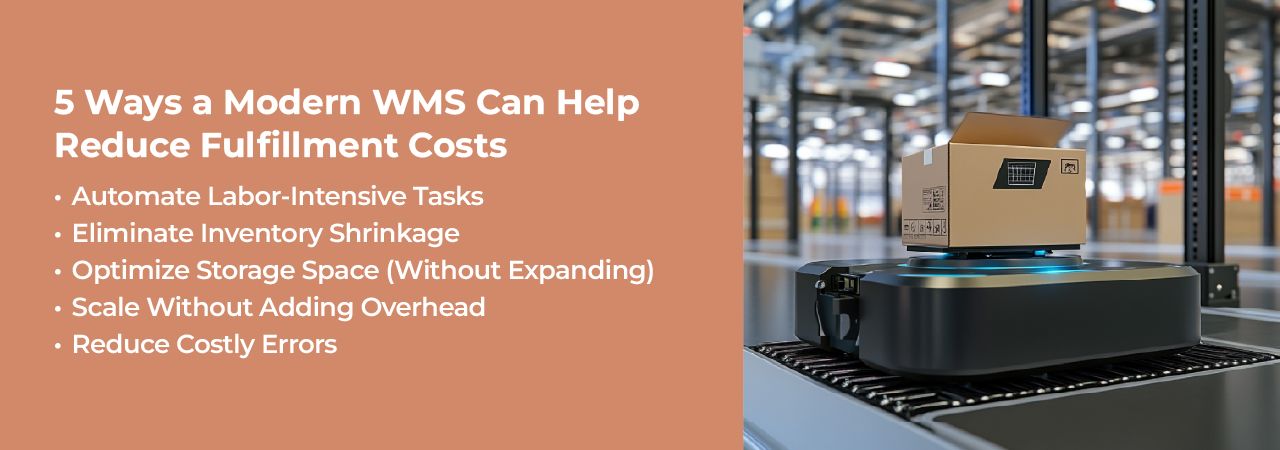How to Reduce Fulfillment Costs by 50% Using a Modern WMS
Are your fulfillment costs quietly eating away your hard-earned profits? Then you're not alone. Inefficient logistics operations in numerous e-commerce, 3PL, and warehouse businesses lead to inflated costs and dissatisfied customers. But what if you could reduce fulfillment costs by 50% or more? Don’t be surprised, it's real. Yes, it is possible by implementing a modern WMS like FulFillor. A modern Warehouse Management System (WMS) is more than just software; it is a valuable asset that has the potential to not only lower your fulfillment costs but also streamline your entire supply chain. Let's explore how.
Why Fulfillment Costs Are Killing Your Profit Margins?
Fulfillment is more than hitting the shipping button — it’s a skillful combination of labor, inventory, and time. Traditional approaches tend to involve manual processes, paper-based monitoring, and limited visibility into inventory amounts, which may result in:
-
Labor overuse: This includes wasted hours in manual picking/packing. Due to the absence of real-time labor productivity visibility, warehouses find it difficult to optimize their labor resources, which results in higher expenditure and operational inefficiency.
-
Manual Processes and Errors: Manual tracking and paper-based systems are susceptible to picking errors, incorrect data entry, and misplaced inventory that result in rework, returns, and wasted labor.
-
Suboptimal Space Utilization: A poor warehouse layout and lack of real-time insights into product velocity or inventory levels can lead to wasted space and higher storage costs.
The fix? An advanced warehouse management system that reduces fulfillment costs through workflow automation, space optimization, and error minimization.
The Modern WMS: Your Weapon Against Rising Fulfillment Costs
Imagine you have a 3D map of the warehouse updated in real time. A Modern Warehouse Management System (WMS) is a digital solution that automates and optimizes your complete warehousing process, including everything from inventory control, order picking, packing, and delivery to real-time tracking. Technologies such as barcode scanning and RFID enable a modern WMS to offer you a real—time, 360-degree view of your inventory at all your locations.
Here’s what a modern WMS generally includes:
- Accessible from the cloud with live data.
- Faster Order Fulfillment with AI-Aided Automation.
- Integrations with shopping carts, marketplaces, and shipping partners on multiple channels.
- Making smart decisions with inventory forecasting and analytics.
- Errorless operation through mobile & barcode scanning.
5 Ways a Modern WMS Can Help Reduce Fulfillment Costs

1. Automate Labor-Intensive Tasks
Pain Point : Labor represents the largest cost component of fulfillment, and much of that effort goes into repetitive, low-value tasks. Think of marching back and forth in a warehouse, individual order picking, or the printer that spits out labels, one by one. It’s tedious, draining, and frankly, a little unnecessary.
Solution: A smart WMS drastically improves this by automating these processes. Workers are led along the most efficient routes by AI-driven pick paths. Batch picking becomes a part of this so that trips can be consolidated. Packing workflows suggest the optimal box size and can even seal it for them. The result? You handle more orders with fewer people, and that’s a direct shot in the arm to labor costs in the best way.
2. Eliminate Inventory Shrinkage
Pain Point: At first glance, inventory shrinkage might not sound like a big deal - until you get to know that it silently eating of 1–2% of your annual revenue. It can be poor inventory visibility, misplaced shipments, theft, and more, which is secretly draining your budget.
Solution: This is where a smart WMS comes in. With real-time tracking from RFID or barcode scanning, everything is accounted for the moment it’s in or out of your warehouse. Daily cycle counts prevent the inconsistencies from becoming catastrophically large. Automated alerts identify suspicious patterns, enabling you to take action before it’s too late. The result is tighter control over your inventory and fewer dollars vanishing.
3. Optimize Storage Space (Without Expanding)
Pain Point: You may believe you have outgrown your warehouse, but what if you’re not utilizing it correctly? Many businesses leave as much as 30% of their warehouse space unused and wasted because of bad layout, chaotic shelving, or slow-moving products occupying prime space.
Solution: A WMS (Warehouse Management System) completely reimagines your layout based on data. Dynamic slotting enables the storage of high-demand items closer to the packing stations for quicker access. Vertical stacking recommendations encourage you to stack up, rather than out. All this means you can store more, move faster, and put off (or avoid) expensive warehouse expansions.
4. Scale Without Adding Overhead
Pain Point: The challenge of growth, particularly in peak seasons, is that it often means more staff, more space, and more stress. Scaling your fulfillment operations doesn’t have to mean scaling your costs.
Solution: You can scale smart with the right WMS. You can make real-time labor adjustments based on the number of orders, so you’re never overstaffed or underprepared. The system communicates across multiple warehouses, avoiding unnecessary transfers and helping balance their stock levels. And with integrations to things like Shopify or FedEx, new orders come in and go off without a human being ever touching a spreadsheet. And that’s how you grow without spending a fortune.
5. Reduce Costly Errors
Pain Point: Let’s be honest — mispicks, wrong shipments, and return hassles are more than just headaches. They result in disgruntled customers, additional shipping costs, and wasted time rectifying avoidable mistakes. Each mistake erodes into your profit margins.
Solution: A modern WMS, such as FulFillor, prevents these problems from happening in the first place. By scanning barcodes and validating orders in real time, the system guarantees that the correct item reaches the right customer on the first attempt. It instills accountability at every stage and streamlines the whole process so your team doesn’t need to double-check every action. In the long run, those saved minutes and fewer returns contribute to significant cost savings.
FulFillor in Action: Real-World Case Study One of our multi-client 3PLs in the US was trying to manage several fulfillment contracts, faced problems such as poor inventory accuracy, high error rate, and high fulfillment costs. Since they have implemented Fulfillor’s 3PL Management Software into their system, they have achieved a 25% decrease in order fulfillment rates and a 50% reduction in order fulfillment costs. This is the wonder of FulFillor WMS for 3PL Fulfillment. Our solution is the next level 3PL Warehouse Management System that maintains your inventory accuracy by adding automated order routing, real-time inventory dashboards, and pre-integrated shipping labels, leading to reduced manual errors.
Conclusion
If you’re committed to achieving operational efficiency and better profit margins, it’s time to upgrade. Being the key to long-term success, a modern warehouse management system is no longer a luxury but a necessity. FulFillor, a next-gen WMS, can help you reduce your fulfillment costs by 50% or more. FulFillor is more than a platform; you gain a partner committed to helping you in lowering fulfillment costs, increasing productivity, and scaling with confidence. Don't let high fulfillment costs eat into your profit margins. Implement a modern WMS today and start seeing the benefits for yourself.
Curious how FulFillor WMS can save your business thousands monthly?
Ready to reduce your fulfillment cost? Schedule your free FulFillor demo today and start saving.
About the Author: Visvendra Singh is a logistics tech professional with more than five years of experience, designing warehouse solutions for e-commerce, retail, and 3PL brands. With a track record of helping businesses in the US and India realize 30-50% reductions in fulfillment costs, he blends technical skill with on-the-ground expertise to enable success.

